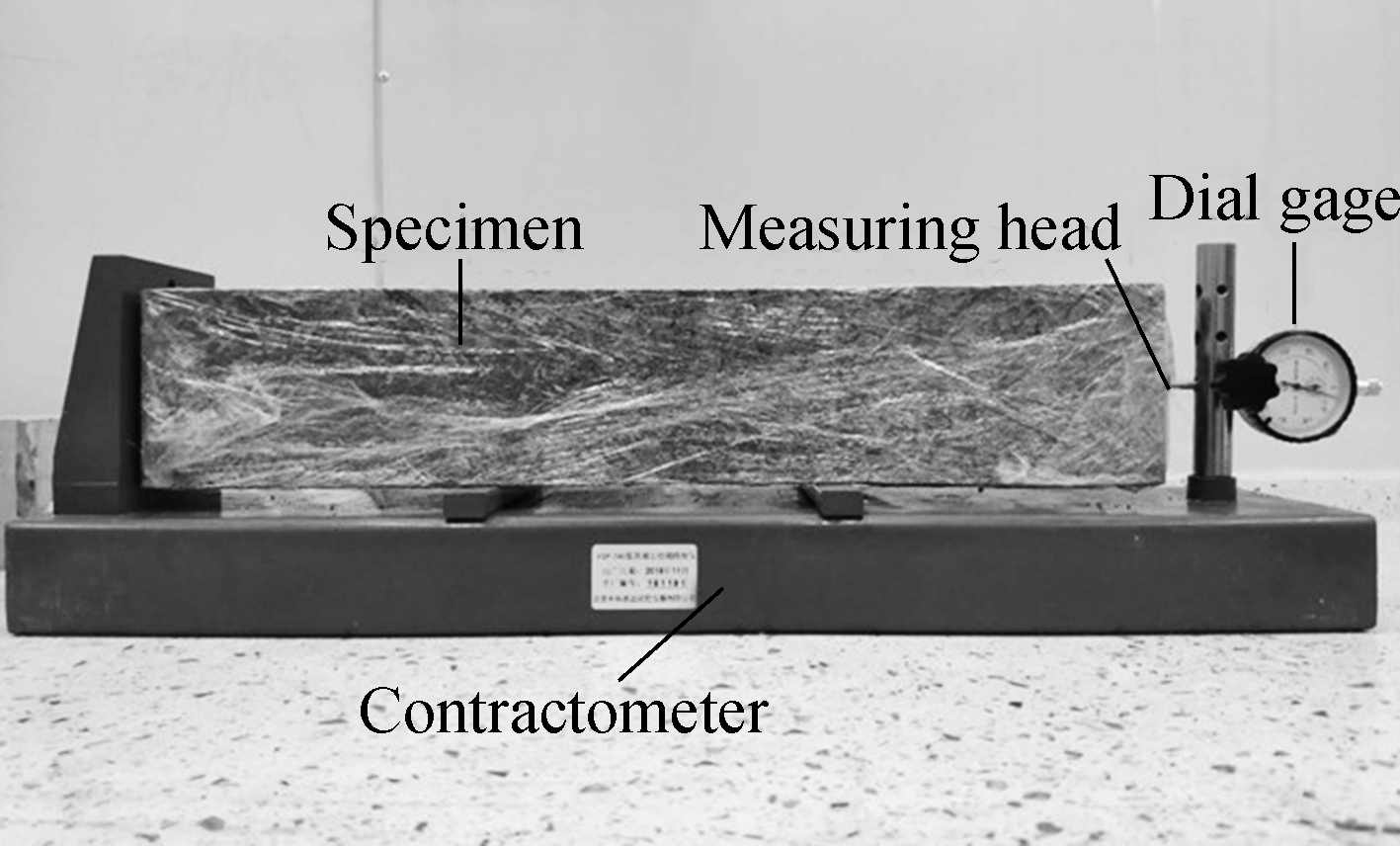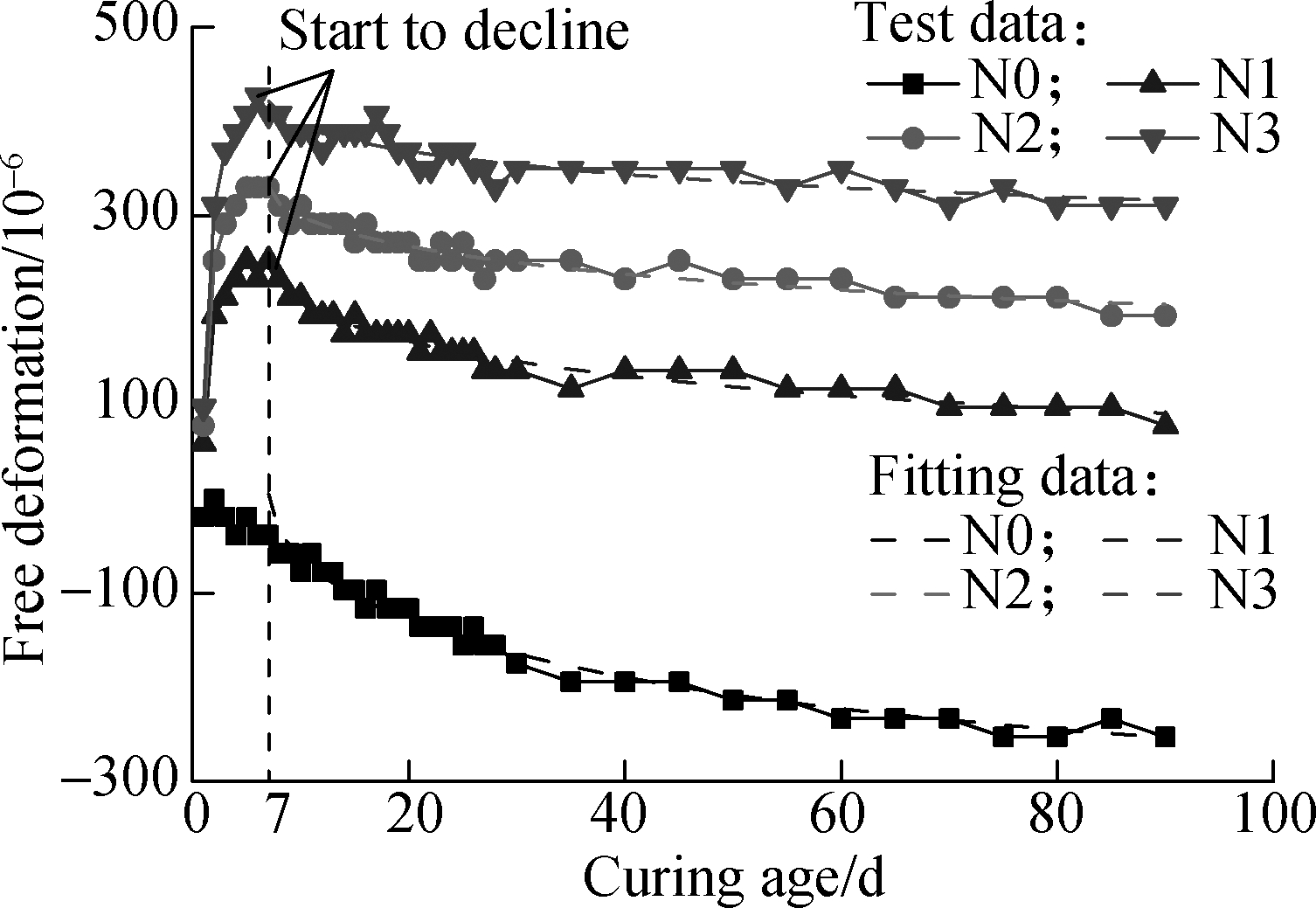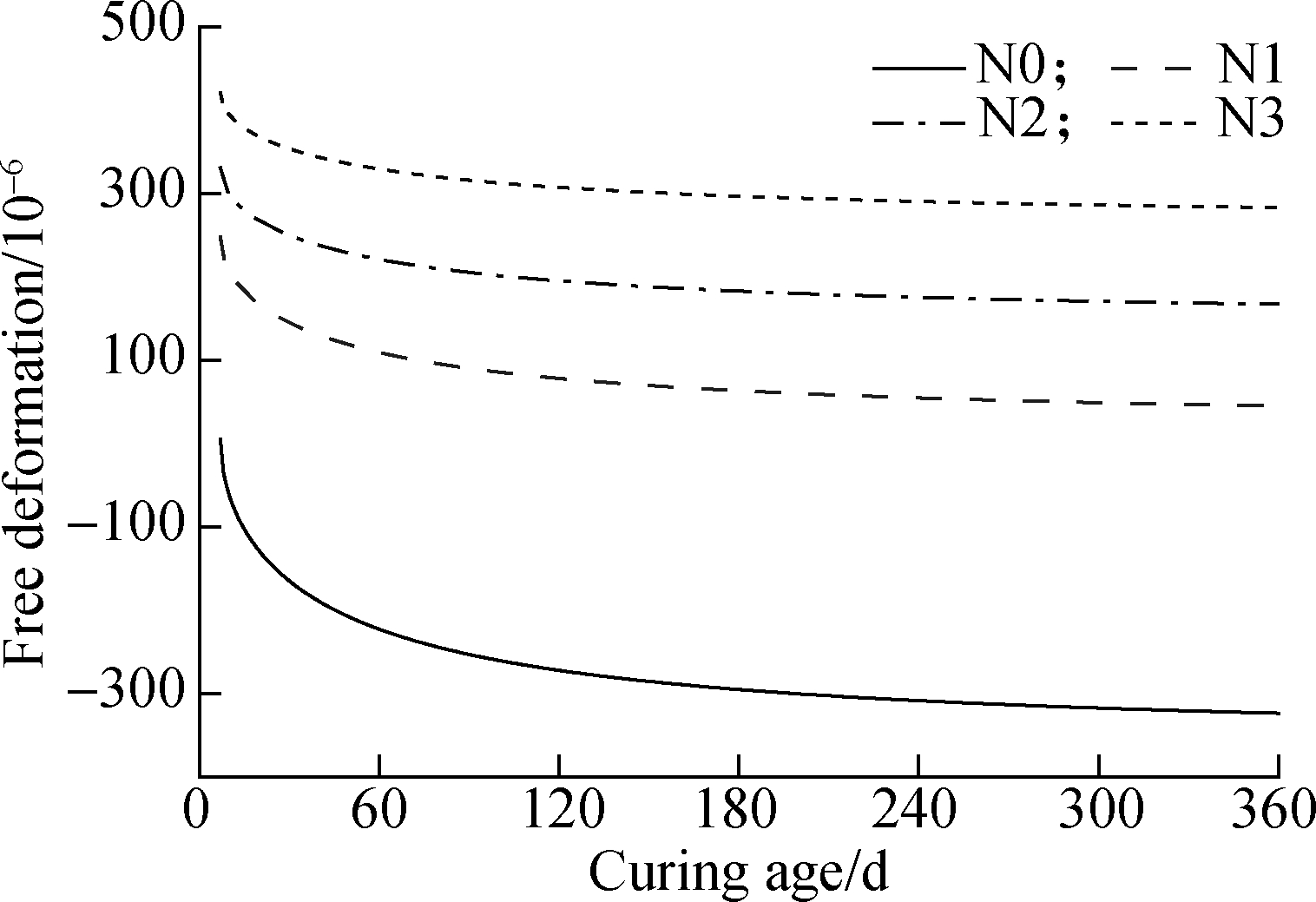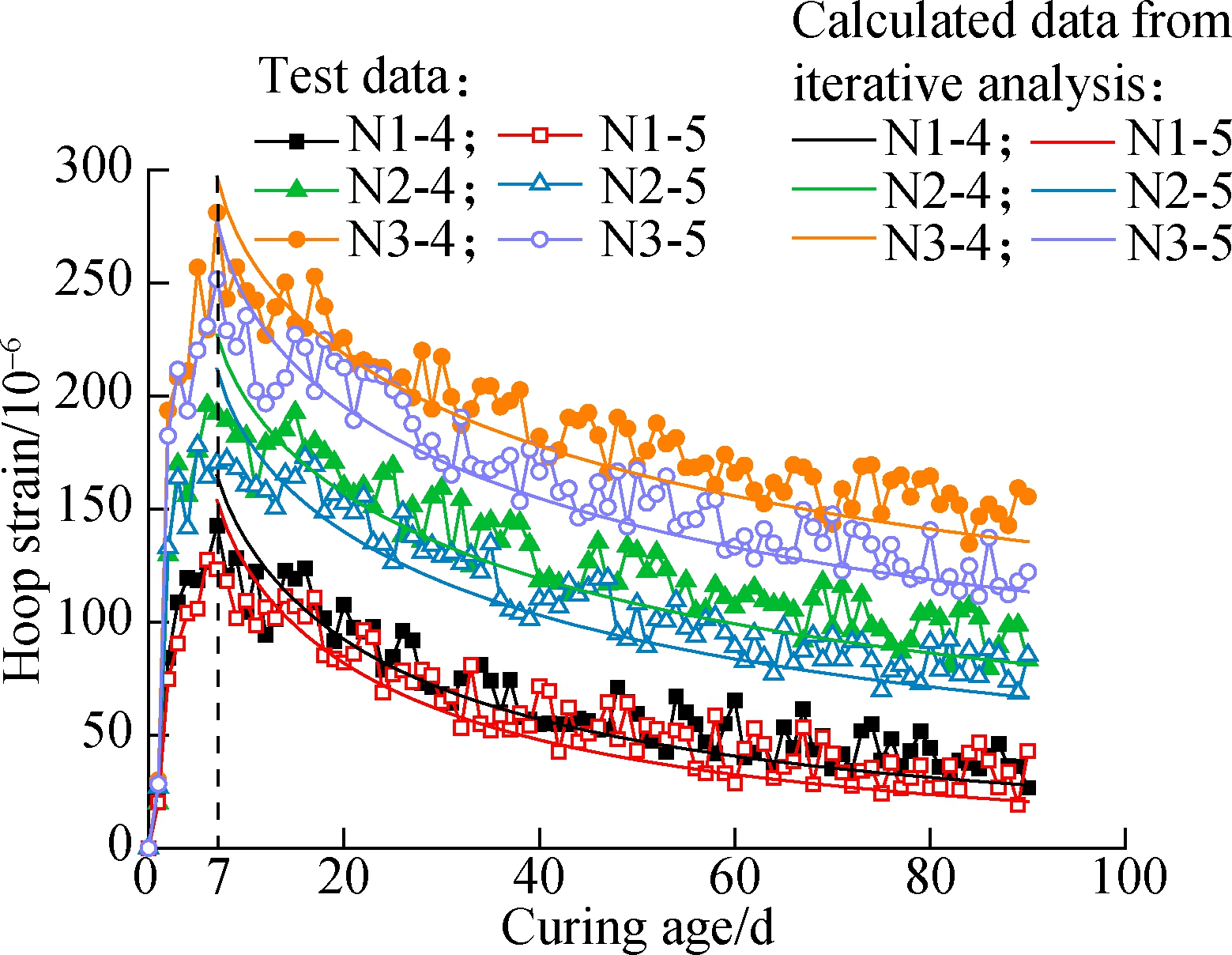Concrete-filled steel tubular (CFST) structures have been widely investigated and used in high-rise buildings and large-span structures due to their significant advantages, such as light weight, high load carrying capacity, excellent ductility and seismic performance[1-3]. The steel tube confines the lateral deformation of internal concrete and the concrete limits the buckling of steel tube when CFST is in compression[4]. Thus, strong interaction between concrete and steel tube should be kept for the excellent mechanical properties of CFST. In other words, the internal concrete should be close to the steel tube.
However, debonding commonly occurs between the steel tube and the internal concrete in CFST structures due to concrete creep, shrinkage and different Poissson’s ratios between the steel tube and concrete[5]. The debonding weakens the interaction of the two materials and reduces the load carrying capacity and ductility of CFST structures[6]. Thus, expansive concrete, obtained by introducing expansive agents into cement, is proposed to substitute ordinary concrete in steel tube[7-9]. The shrinkage is well compensated by the expansion, and close contact can be achieved between steel tube and concrete. Moreover, the concrete expansion can be restrained by the steel tube. Compressive stress is thus generated between the two materials, which is so-called self-stress[10].
Some studies were conducted to investigate the influence of the self-stress on the mechanical performance of CFST. The experiments in Ref.[11] found that an increase of 12.4% in load capacity was observed for the self-stressing CFST columns having a self-stress of 5 MPa. The improvement became more significant with the increase in the length-to-diameter ratio. The degree of increase in load capacity was also related to the initial self-stress, tube thickness and concrete strength[12]. Li et al.[13] tested 18 self-stressing CFST columns with different initial self-stresses, tube thicknesses, and concrete strengths under axial compression. The test found that the initial self-stress significantly increased the load capacity of CFST columns but reduced its deformability. However, the increase in the load capacity was negligible when the self-stress was low. Excessively high self-stress could adversely affect the load capacity, and the optimum self-stress level was 0.101.
Self-stress is crucial to the mechanical performance of CFST columns[10-13]. The self-stressing behavior must be acquired when designing the CFST structures. Most researchers calculated the self-stress by utilizing the strain of steel tube according to the third law of Newtonian mechanics[11]. The hoop strain and axial strain of steel tube were measured during tests, and this method was not feasible for engineering application. Some formulas were also proposed to calculate the self-stress of CFST according to elastic mechanics[14]. The formulas indicated that self-stress was directly related to concrete expansion. However, the expansive deformation varies over time due to concrete shrinkage and creep. The concrete creep in self-stressing CFST is greater than the creep of ordinary concrete due to the self-stresses[15]. Test results from Zhang et al.[16] found that the dosage of expansive agents and the stress ratio had significant effects on the creep strain of CFST. Thus, the creep development in the internal concrete may influence the expansive deformation significantly, and cause the loss of self-stress. Concrete creep should be considered when evaluating the self-stress of CFST. Nevertheless, the creep effect is not taken into account in these existing formulas.
Thus, this paper proposed a calculation method to study the expansion performance and self-stressing behavior of self-stressing CFST columns considering the effect of concrete creep and shrinkage. Deformation tests were conducted on concrete and CFST specimens, respectively. The calculation results were compared with the test results to validate the reliability of the calculation method.
1 Expansive Deformation Tests
1.1 Materials and mix design
Mix proportion tests were conducted to obtain the self-compacting and expansive concrete with good mechanical properties. Materials used in concrete included PⅡ42.5 Portland cement, fly ash (FA), sand, coarse aggregate, polycarboxylate-series superplasticizer (SP) and HME-IV concrete expansive agent (EA). EA contained primarily calcium oxide, calcium sulphoaluminate and gypsum. It substituted part of the cementitious materials in concrete to produce a certain volume expansion and eliminate the concrete shrinkage. Different dosages of EA were used in the mixture to study its influence on the mechanical and expansion performance of concrete. The detailed mix proportions are listed in Tab.1.
Tab.1 Mix proportion of concrete (weight ratio)

No Dosage of EA %CementFAEAWaterSandCoarse aggregateSPN000 800 20000 301 2231 8350 01N15 00 760 1900 0500 301 2231 8350 01N27 50 740 1850 0750 301 2231 8350 01N310 00 720 1800 1000 301 2231 8350 01
Note:1) Dosage of EA means the ratio of admixture to binder; binder contains cement, FA, and EA. 2) The maximum size of coarse aggregate is 20 mm.
Slump tests, uniaxial compression tests, and elasticity modulus tests were conducted to evaluate the workability and mechanical properties of concrete. Cubic specimens with dimensions of 100 mm×100 mm×100 mm and rectangular specimens with dimensions of 100 mm×100 mm×300 mm were prepared and tested for compression tests and elasticity modulus tests, respectively. The corresponding results are shown in Tab.2. The slump extension and compressive strength of concrete decreased gradually with the increase in the dosage of EA. However, the elastic modulus of concrete exhibited no significant correlations with the dosage of EA. Reducing cementitious materials decreased the strength of concrete. Whereas the addition of EA could densify the concrete microstructure, which was beneficial for the strength. Thus, the difference in the compressive strength of the specimens was insignificant. The compressive strength and elastic modulus of the specimens increased with the increase in the curing age, more rapidly in the early stage.
Tab.2 Workability and mechanical properties of concrete

No Slump extension mmCompressive strength MPa28 d60 d90 dElastic modulus GPa28 d60 d90 dN059554 759 361 633 535 435 8N159054 159 561 232 935 136 0N258053 458 860 333 434 835 7N358551 257 960 133 135 936 9
1.2 Test program
Expansive deformation tests were conducted, including the free deformation test and the constrained deformation test, to measure the free deformation of concrete and the circumferential deformation of the steel tube in CFST, respectively. The free deformation test consisted of four groups of specimens(N0-N3). Each group had three specimens. All specimens had an identical dimension of 100 mm×100 mm×515 mm. A horizontal contractometer equipped with a dial gauge of ±0.01 mm accuracy was used to measure the horizontal deformation of the specimens. The test setup was according to “Standard for test methods of long-term performance and durability of ordinary concrete” (GB/T 50082—2009)[17]. Two measuring heads were in two ends of the specimens. The specimens demolded 24 h after casting. Then, the specimens were coated with vaseline and wrapped in plastic to simulate the closed environment in steel tube. The tests were conducted in the environment with a temperature of (20±2)℃. The length of the specimens was measured every day in the first 30 d, and then measured every 5 d. The test setup is shown in Fig.1.

Fig.1 Test setup for free deformation test
In the constrained deformation test, the hoop strain of steel tube was measured to observe the expansion process of the self-stressing concrete. Six CFST columns were tested to study the influence of the steel ratio and dosage of EA on the expansion performance. The detailed specimen information is shown in Tab.3. All steel tubes (Q235) had an identical external diameter (159 mm) and height (477 mm), as shown in Fig.2. Both ends of the steel tube were welded on a steel plate to ensure a closed environment. Three strain gauges were attached in the middle of each steel tube, and the strain values were monitored continuously for 90 d. The temperature always remained at (20±5)℃ during the whole test.
Tab.3 Detailed specimen information

No Dosage of EA %Thickness of steel tube mmN1-45 04N1-55 05N2-47 54N2-57 55N3-410 04N3-510 05

Fig.2 Dimensions of the CFST specimens(unit:mm)
1.3 Test result
The free deformation of concrete varied with the curing age, as shown in Fig.3(a). Specimen N0, without the addition of EA, exhibited a noticeable shrinkage with the increase in the curing age. In contrast, specimens N1-N3, which contained EA, expanded rapidly in the early stage. The free deformation of specimens N1-N3 reached the peak on the 6th or 7th day, then started to decline with the increase in the curing age. The free deformation of specimens N1-N3 was equal to the expansive deforma-tion minus the shrinkage deformation. The expansive deformation was caused by adding EA and was closely correlated with the dosage of EA.

Fig.3 Free deformation-curing age curves
The free deformation of concrete started to decline on the 7th day, which indicates that the shrinkage is more dominant in subsequent deformation than the expansion. Thus, the following equation was used to predict the free deformation of concrete after 7 d of casting, which referred to the shrinkage model in CEB-FIP (1990)[18].
(1)
where ε0 is the free deformation; t is the curing age; parameters A, B and C were determined by the regression analysis of the test data, which were relevant to the dosage of EA. The free deformation of concrete was only related to the dosage of EA and the curing age. Parameters A and B determined the initial and final free deformation. Parameters B and C determined the variation rate of the free deformation. The values of A, B and C for the specimens are listed in Tab.4. Parameters A, B and C had an approximately linear relationship with the dosage of EA. Thus, the free deformation of concrete can be calculated by fitting above results.
(2)
Tab.4 Fitting parameters for specimens N0-N3

No ABCN0 5 5365 683 2N1247 9226 889 5N2331 3184 896 8N3421 3156 2101 3
The fitting curves of free deformation for specimens N0-N3 during 90 d are shown in Fig.3(a) by dash lines. Fig.4 depicts the free deformation of specimens N0-N3 during 360 d. The free deformation of specimens N1-N3 was still positive on the 360th day, indicating that the specimens were still expanding after 360 d.

Fig.4 Free deformation-curing age fitting curves
In the CFST specimens, the expansion of internal concrete produced tension stress in the steel tube. The hoop strain of the steel tube exhibited the same variation trend with the curing age, namely the free deformation of concrete increased significantly in the initial 7 d and decreased later. An increase in the thickness of steel tube decreased the hoop strain, as shown in Fig.5.

Fig.5 Hoop strain-curing age curves
2 Analysis of Expansive Deformation and Self-Stressing Behaviour
2.1 Proposed calculation method
The CFST can be divided into two parts: steel tube and internal concrete. In the process of the stress analysis, the steel tube is thought to be subjected to a biaxial state of stress for simplicity. The stress state of a micro-unit in the steel tube is depicted in Fig.6.

Fig.6 Stress state of a micro-unit in steel tube
According to the equilibrium condition, we have
(3)
where r is the radius of the micro-unit; σt and σr are the hoop and radial stress, respectively. Corresponding strain εt and εr can be expressed as
(4)
(5)
where u is the radial displacement of a cylindrical surface with a radius of r.
The stress-strain relationship can be established according to the generalized Hook law as follows:
(6)
(7)
where Es and μ are the elastic modulus and Poisson’s ratio of steel, respectively.
The radial stress of the internal and external face of the steel tube are equal to the self-stress (q) and 0, respectively. Thus, the hoop and radial stress can be calculated by
(8)
(9)
where a and b are the internal and external diameter of the steel tube, respectively.
It can be concluded that the hoop stress is significantly greater than the radial stress. The hoop stress of the internal and external face of the steel tube (σt,a, σt,b) are expressed as
(10)
(11)
where k is a constant related to the dimension of the steel tube and is equal to (b2+a2)/(b2-a2).
The self-stress of the internal concrete ignoring the concrete creep can be expressed as
q=Ec(ε0-εR)
(12)
where ε0 and εR are the concrete strain in the free and constrained state, respectively; Ec is the elastic modulus of concrete. εR is equal to εt,a, namely the hoop strain of the internal face of steel tube. Thus, εR and q can be calculated by
(13)
(14)
Concrete creep occurs under the self-stress. The creep increases gradually with time and causes the self-stress to chang. Moreover, the growth rate of the creep is dependent on the self-stress. Thus, an iterative analysis should be adopted to study the self-stress development. The computing process is as follows:
1) Calculate the initial free expansive strain ε0, constrained strain εR0 and self-stress q0 at time t0;
2) Determine the time step Δti(Δti=ti-ti-1);
3) Calculate the creep strain εci at time ti;
4) Calculate the free expansive strain considering the creep effect ![]() constrained strain εRi and self-stress qi at time ti;
constrained strain εRi and self-stress qi at time ti;
5) Iterate steps 2)-4) until ti reaches the target time T or negative εRi or qi appear. In the iterative analysis, the creep strain is calculated by the creep coefficient in CEB-FIP (1990) [18], which is only related to the material and curing environment. The concrete creep and self-stress are assumed to occur after 7 d of casting, which is because concrete hardening may not complete in the early stage. A detailed program flowchart is shown in Fig.7.

Fig.7 Program flowchart
2.2 Calculation result
2.2.1 Hoop strain of steel tube
The iterative analysis was conducted by software MATLAB. The hoop strain of the external face of steel tube calculated by MATLAB (solid lines) was compared with the experimental results, as shown in Fig.5. The estimated date agreed well with the test data, which indicates that the calculation method is capable of predicting the expansive deformation of CFST with reasonable precision. However, two apparent differences were observed between the test data and the estimated data. The peak values of the calculated curves were much smaller than those of the test curves. It is because the self-stress and concrete creep were already present during the initial 7 d, while they were not considered during the calculation process. The other difference was that the calculated curves decreased more rapidly and were lower than the test curves after 15 d. It is because the calculated curves were obtained based on the biaxial state of stress. However, the ends of the steel tube in the test were welded on steel plates to ensure a closed environment. The steel plates constrained the axial expansion of the internal concrete and produced axial tension strain in the steel tube. The measured hoop strain was greater than the calculated results due to the Poisson effect.
The estimated hoop strain of the steel tube during 360 d is shown in Fig.8. Both the hoop strain and its variation rate decreased with the increase in the curing age and tended to be stable finally. The hoop strain of specimens N1-4 and N1-5 were almost 0 on the 360th day. Thus, debonding may probably occur between the internal concrete and the steel tube due to the creep development when few EA were used. The hoop strain of specimens N2-4 and N3-4 were nearly 2 and 3 times that of specimen N1-4 on the 360th day, respectively. This indicates that increasing the dosage of EA can prevent the debonding effectively. The hoop strain of specimen N3-5 was smaller and declined more rapidly than that of specimen N3-4. The descending rate of the hoop strain was related to the self-stress. A corresponding explanation was stated in Section 2.2.2.

Fig.8 Calculated hoop strain-curing age curves
2.2.2 Self-stress of internal concrete
The estimated self-stress and creep deformation of the internal concrete during 360 d are shown in Fig.9 and Fig.10. The self-stress declined with the increase in the curing age due to the development of concrete creep and shrinkage. The loss of self-stress for all specimens were higher than 70% of the initial self-stress after 360 d. The self-stress and creep deformation were up to the expansive deformation, so they increased with the increase in the dosage of EA. For the specimens with the same dosage of EA, larger tube thickness offered a stronger constraint on internal concrete, and resulted in a larger initial self-stress and creep deformation. The self-stress of specimen N3-5 was higher than that of specimen N3-4 during the initial days. Meantime, the hoop strain of specimen N3-5 decreased more rapidly, as shown in Fig.6. However, the concrete creep and self-stress development were interactional. Large creep deformation accelerated the decline of self-stress. Fig.11 depicts the self-stress-creep deformation curves. Compared with the specimens with a tube thickness of 4 mm, the self-stress of the specimens with a tube thickness of 5 mm decreased more rapidly. The self-stress of specimen N1-5 was even smaller than that of N1-4 when the curing age reached 64 d. The creep deformation tended to be stable as the curing age increased. The creep deformation of the specimens ranged from 14.6×10-6 to 35.6×10-6 on the 90th day, accounting for 10%-22% of the free deformation, as shown in Fig.3(a). This indicates that the creep deformation cannot be ignored when studying the expansion performance of CFST columns.

Fig.9 Calculated self-stress-curing age curves

Fig.10 Calculated creep deformation-curing age curves

Fig.11 Calculated self-stress-creep deformation curves
3 Conclusions
1) The expansive concrete prepared in the study expands rapidly in the initial stage and shrinks gradually after 7 d. Free deformation of concrete increases with the increase in the dosage of EA. The expansive concrete with a 7.5%-10% dosage of EA can maintain expansion for a long time.
2) The hoop strain of the steel tube in CFST columns increases significantly in the initial 7 d and decreases later. Both increasing the dosage of EA and reducing the tube thickness increase the hoop strain. A proper addition of EA to internal concrete can prevent the debonding between steel tube and internal concrete.
3) The expansive deformation of CFST columns can be well predicted by the calculation method proposed in this study. The self-stress decreases with the increase in the curing age. The loss of self-stress for all specimens were greater than 70% of the initial self-stress after 360 d. Increasing the tube thickness of CFST columns increases the initial self-stress, while hastening the descending process of self-stress with the curing age.
4) Increasing the curing age, dosage of EA and tube thickness increases the creep deformation of concrete. Creep deformation affects the development of self-stress. Creep deformation accounts for 10%-22% of the free deformation, and cannot be ignored when studying the concrete deformation in CFST columns.
[1] Zhang Y F, Zhang Z Q. Study on equivalent confinement coefficient of composite CFST column based on unified theory[J].Mechanics of Advanced Materials and Structures, 2016, 23(1): 22-27. DOI:10.1080/15376494.2014.922650.
[2] Wang Z B, Tao Z, Han L H, et al. Strength, stiffness and ductility of concrete-filled steel columns under axial compression[J].Engineering Structures, 2017, 135: 209-221. DOI:10.1016/j.engstruct.2016.12.049.
[3] Ahmadi M, Naderpour H, Kheyroddin A. ANN model for predicting the compressive strength of circular steel-confined concrete[J].International Journal of Civil Engineering, 2017, 15(2): 213-221. DOI:10.1007/s40999-016-0096-0.
[4] Xu L, Pan J L, Cai J M, et al. Mechanical behavior of flat CFST column to steel beam joints under reversed cyclic loading[J].Engineering Structures, 2019, 198: 109540. DOI:10.1016/j.engstruct.2019.109540.
[5] Xue J Q, Briseghella B, Chen B C. Effects of debonding on circular CFST stub columns[J].Journal of Constructional Steel Research, 2012, 69(1): 64-76. DOI:10.1016/j.jcsr.2011.08.002.
[6] Cai J M, Pan J L, Shan Q F. Failure mechanism of full-size concrete filled steel circle and square tubes under uniaxial compression[J].Science China Technological Sciences, 2015, 58(10): 1638-1647. DOI:10.1007/s11431-015-5890-4.
[7] Lu Y Y, Liu Z Z, Li S, et al. Bond behavior of steel fibers reinforced self-stressing and self-compacting concrete filled steel tube columns[J].Construction and Building Materials, 2018, 158: 894-909. DOI:10.1016/j.conbuildmat.2017.10.085.
[8] Maruyama T, Karasawa H, Hashimoto S, et al. Effect of expansive agent and temperature on the quality of pre-cast concrete products[J].International Journal of Civil Engineering, 2017, 15(2): 263-271. DOI:10.1007/s40999-016-0080-8.
[9] Han J G, Jia D, Yan P Y. Understanding the shrinkage compensating ability of type K expansive agent in concrete[J].Construction and Building Materials, 2016, 116: 36-44. DOI:10.1016/j.conbuildmat.2016.04.092.
[10] Chang X, Huang C K, Chen Y J. Mechanical performance of eccentrically loaded pre-stressing concrete filled circular steel tube columns by means of expansive cement[J].Engineering Structures, 2009, 31(11): 2588-2597. DOI:10.1016/j.engstruct.2009.06.007.
[11] Xu L H, Zhou P H, Chi Y, et al. Performance of the high-strength self-stressing and self-compacting concrete-filled steel tube columns subjected to the uniaxial compression[J].International Journal of Civil Engineering, 2018, 16(9): 1069-1083. DOI:10.1007/s40999-017-0257-9.
[12] Huang C K, Xu L, Liu Y. Research on mechanical performance of self-compacting and self-stressing concrete-filled steel tube short column under axial loading[J].Journal of Dalian University of Technology, 2006, 46(5): 696-701. DOI:10.3321/j.issn: 1000-8608.2006.05.014.(in Chinese)
[13] Li N, Lu Y Y, Li S,et al. Experimental study on self-stressing and self-compacting concrete-filled circular steel tube short columns subjected to axial compression[J]. Journal of Building Structures, 2019, 40(11): 162-171. DOI:10.14006/j.jzjgxb.2017.0807.(in Chinese)
[14] Hu S G, Ding Q J.Concrete-filled steel tube[M]. Beijing: China Communications Press, 2007. (in Chinese)
[15] Xu L, Huang C K, Gao D Y. Creep computation module of self-stressing concrete-filled steel tube under axial load[J]. Journal of Harbin Institute of Technology, 2009, 41(10): 118-122.(in Chinese)
[16] Zhang R L, Wang Q C, Ma L N,et al. Effect of interaction between expanding agent proportion and stress ratio on creep characteristics of concrete filed steel tube[J]. Journal of Central South University (Science and Technology), 2014, 45(7): 2416-2423.(in Chinese)
[17] Ministry of Housing and Urban-Rural Development of the People’s Republic of China. Standard for test methods of long-term performance and durability of ordinary concrete: GB/T 50082—2009[S]. Beijing: China Architecture & Building Press, 2009. (in Chinese)
[18] Comite Euro-International Du Beton. CEB-FIP model code 1990[M]. London: Thomas Telford Publishing, 1993.